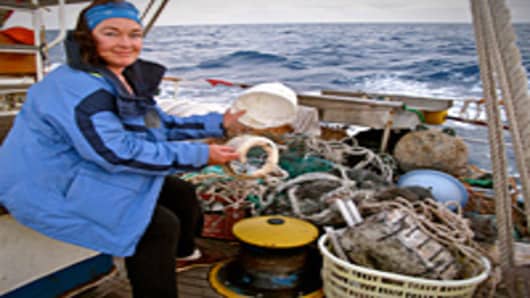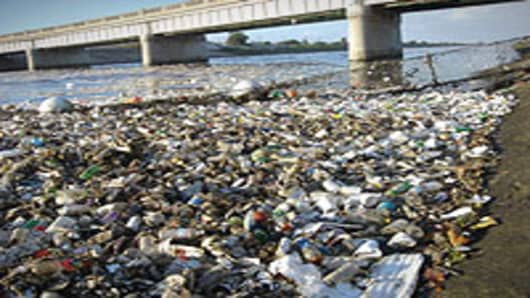With an estimated 100 million tons of plastic afloat in the Pacific Ocean already, ocean-borne plastics are a huge environmental problem.
But new technology, consumer education and a long-term vision could be coming to the rescue.
“We find a diversity of things, from toothbrushes, car fenders, every type of bottle and bucket, to derelict fishing gear,” says Mary Crowley, co-founder of Project Kaisei, a California-based initiative to clean up the plastic-laden “trash patch” caught in North Pacific gyre.
“From being out there twice, it’s easy to find garbage,” she says of the gyre, where a confluence of currents collects floating debris. “There’s all too much garbage.”
Her organization is working with naval architects to repurpose oil skimming technology and redesign existing fishing technologies to start the cleanup.
“One way would simply be to adapt fishing technology,” she says. “You’re really just fishing for plastic, so there’s no need to reinvent the wheel.”
Unlike beach or coastal cleanups, one challenge with collecting waste at sea is storage.
Crowley says she envisions smaller cleaning craft taking their plastic payloads to a “mothership,” similar to how oil spill cleanup works today, which would then take a large load of plastics ashore.
The scale of this oceanic pollution is hard to fathom. Despite recent descriptions of garbage gyres in the Pacific, Atlantic and other oceans, there’s no “floating island” of plastic trash.
Plastics are found in higher densities in the gyres, but there's still millions of square miles of ocean where the debris floats in small individual pieces, collects around a larger piece of flotsam, or gets caught inside lost fishing gear.
Capt. Charles Moore, founder of Algalita Marine Research Foundation, says this dispersion makes removal is a tough option.
"A lot of people love the ocean and they realize ocean trash is becoming more of an issue."
“The ocean out there is a third of the surface area of the entire globe,” he tells CNBC's Carl Quintanilla. “That's an enormous area to try to clean up. It's just not economically feasible to do it.”
He says focusing on reducing the amounts of plastics used, to keep more from making it to the ocean, is a better idea.
Angela Howe, litigation manager with the coastal waters non-profit Surfrider Foundation, agrees.
Her group has organized beach cleanups for 25 years, but she cautions that at-sea collection methods aren’t proven and could cause more damage.
“What’s the by-catch?” she asks, referring to sea life that may get caught up in the plastic removal process. “I don’t think there’s enough research.”
But source reduction is an uphill battle.
Since coming of age in the post-WWII era, plastic’s low cost, light weight and durability have seen it permeate every industry, from auto-making and construction, to food production and medical services.
According to plastics recycler Plastinum Polymer Technologies, global plastics production has risen from 5 million tons in 1950 to 270 million tons in 2007—growing 250 percent since 1990 alone.
And those figures don’t include some popular plastics, like polyethylene terephthalate—also known as PET, or “#1” plastic, commonly found in soda and water bottles.
Currently, the US consumes about 200 pounds of plastic per capita annually, and that’s expected to rise by nearly 50 percent by 2015.
Some of that added production will inevitably wind up at sea, and that makes removal necessary, says Project Kaisei’s Crowley.
New technologies could also allow Crowley’s conceptual “garbage navy” to stay offshore for longer stretches.
Portland-based Agilyx has a process to convert plastic waste into a synthetic crude oil, at a price competitive with crude today.
Their first test facility, opened this past April, can convert up to 20,000 pounds a day of mixed plastics into 2,000 gallons of oil. And with a 2,000 sq. ft. footprint, it could work in a ship-borne environment.
Agilyx’s system is designed to accept mixed plastics contaminated by organic materials and weathered by exposure, the kind of waste expected to be found at sea.
“The problem is economics,” says Agilyx CEO Chris Ulum, referring to recycling the ocean-borne plastics. “It’s recyclable (by other methods) but it’s just not economically recyclable.”
Ulum points out that on land, his firm can turn an inexpensive feedstock—the landfill-bound plastic waste left over after valuable plastics, like PET, are removed by recyclers—into $40-a-barrel crude oil.
“We don’t compete with traditional recycling, we extend it,” he says.
Funding this massive collection effort would be tough, concedes Crowley, so if a technology like Agilyx’s can squeeze revenue from the collected waste, it could help defray costs.
That said, don’t expect massive profits from her initiative at this point, she says.
Since the garbage patches have been publicized, she’s received lots of calls from “people who want to mine the oceans” of plastics, adding that many of them have been “unfunded.”
But she is optimistic that the right technology will be found.
“There are a lot of people in industry working on this, too,” she says. “I am sure at some point down the line, we will be doing some kind of recycling at sea.”
She points out one her organization’s partners, Coca-Cola , is helping out by testing some retrieved plastics from their last voyage, to determine how long it’s been afloat.
Ultimately, she says, the same movement that tackled plastic waste on land will tackle it at sea, too.
“A lot of people really love the ocean,” she adds. “And they realize ocean trash is becoming more of an issue.”
On Wednesday, September 29 at 9pm ET/PT, CNBC presents “Trash Inc: The Secret Life of Garbage,”a CNBC Original reported by Carl Quintanilla that takes an inside look at what happens to our garbage after we throw it out – where it goes, who touches it, and who makes money.
- Cool Interactive 50-State Map: Trash Across America
- Quiz: Test Your Knowledge of E-Cycling




